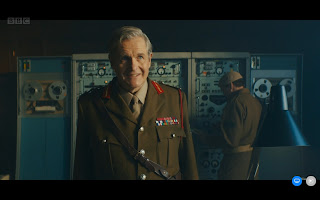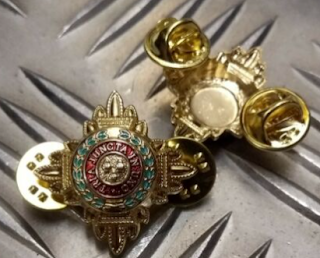Coming soon...
UNIT Uniforms
Through the Ages

Monday, 23 May 2022
Monday, 29 November 2021
The Chibnall Years: 2018 - 2022
“Doctor Who: Flux”
"Survivors of the Flux"
I
am not going to go into the timeline, and the dating of the UNIT stories here,
because there are other websites that will go into far more detail about it than
I. Needless to say, this episode merely added to the already confused
chronology of UNIT and certainly raised a whole host of questions.
We
learn in this episode that the very first Commanding Officer of the British
branch of UNIT (and indeed the man who set it all up – presumably as part of a concerted
United Nations operation) was General Farquhar. The general wears a standard
British Army general’s Service Dress uniform.
On
his upper left arm he wears a UNIT patch, which matches the patches worn by the
likes of Brigadier Lethbridge-Stewart, Captain Yates, and Sergeant Benton on
their Service Dress uniforms.
Farquhar
was also correctly wearing the red lanyard that we saw UNIT officers wearing
during this period – except he was wearing on the wrong arm. The Brigadier and
other officers always wore their lanyards on the right. It should be noted that
we did sometimes see Sergeant Benton wearing his lanyard on the left, however.
One final observation about the general (technically an error, but an eminently forgivable one); you can see on a number of occasions that the rank insignia on the general’s epaulettes are attached using clip pins.
This is the modern way to attach rank insignia.
In the 1960s it would have been attached using split pins.
The UNIT soldiers in this episode are wearing British Battledress uniform.
This is an anachronism for two reasons. Firstly, UNIT troops in these early years wore the beige uniforms seen in “The Invasion” and “Spearhead from Space” etc. (UNIT Uniforms: The Early Years: 1968 - 1970) – of course, it’s entirely possible that UNIT troops were initially kitted out with uniforms from their home-country’s armed forces, before switching to the beige uniform a year or two later. But that brings us to the second problem; the British Army stopped wearing Battledress uniforms in 1961, so they are seven years out of date. But look closer and it’s even more anachronistic that it seems.
There
were three styles of Battledress worn by the British Army – 1937 pattern, 1940
pattern, and 1949 pattern.
 |
| 1937 pattern |
 |
| 1940 pattern |
 |
| 1949 pattern |
Having
said all that, there is precedent for UNIT troops wearing out-of-date uniforms.
During the Golden Years of Pertwee’s Third Doctor, UNIT were kitted out in 1960s
combat fatigues, despite being in the 1970s (or was in the 80s?). Ironically,
the combat fatigues they wore in those days are what they should more correctly
be wearing in this episode, since it is set in 1967.
The
soldiers in this episode wear their Battledress open at the collar, with a
shirt and tie beneath.
We
also get a very brief glimpse of modern UNIT in this episode. In addition to
Kate Stewart, we see a female UNIT soldier ordered to aim missiles at Earth.
She is wearing a black shirt which was last seen being worn by UNIT personnel
at the UNIT command post in Turmezistan in “The Zygon Invasion”.
She
also wears the old RTD style UNIT wings as a patch on her upper sleeves, and as
a badge on her red beret, which is folded under her epaulette.
In
the scene at UNIT HQ, General Farquhar hears the voice of Lethbridge-Stewart
(taken from an audio-clip of Nicholas Courtney in the episode “Terror of the
Autons”). Farquhar then says, “That’s our new Corporal”.
This
line entirely ruins the whole UNIT scene for me. Corporals are NCOs, whereas
Lethbridge-Stewart was an officer. These are two entirely different career
routes in the army, and someone who was a corporal (which is a very junior
rank), would never rise to the rank of Brigadier – as you can see from the table
below.
(And
on another note, based on this episode, are we now also assuming that he was
with UNIT all along in “The Web of Fear”?)
Frankly,
the “Corporal” line was an example of lazy writing and no research on how the
military works. What would have been better is if Farquhar had said, “That’s
our new Colonel.” That would have made far more sense.
The
Lethbridge-Stewart cameo had the potential to be a highlight of the episode and
have me squealing in delight. Instead, the glaring mistake just had me sighing
and rolling my eyes.
It
is not just Doctor Who that is guilty of this (although it has been a
major offender in recent years), but I do wish that if modern writers are going
to write about the military, they would actually do some research to find out
how it actually works. The Ministry of Defence has a very useful page on their
website about it:
Rank Progression
- British Army Jobs (mod.uk)
Wednesday, 10 March 2021
Doctor Who Figurine Collection
The Doctor Who Figurine Collection has released this wonderful "Day of the Daleks" set - highly recommended.
I was lucky enough to be able to provide some insight into the UNIT uniforms in the accompanying magazine.
Thursday, 15 June 2017
Wednesday, 27 January 2016
Commanding Officers
Brigadier Alistair Gordon Lethbridge-Stewart
c.1968 – 1976
Lethbridge-Stewart was the first Commanding Officer of the UK Branch of UNIT having being appointed to this position when the organisation was founded.
We do not know what date UNIT was founded due to the UNIT Dating Controversy, but 1968 was the year “The Invasion” first aired, which was UNIT’s first onscreen appearance. Lethbridge-Stewart retired as CO in 1976, as stated in “Mawdryn Undead”. However, he continued to be called back into service by UNIT on a number of subsequent occasions.
Colonel Faraday
1976 – c.1980
Colonel Faraday appears in “The Android Invasion”. Though not explicitly stated in the show, I would argue that it was Faraday who took over command of UNIT when Lethbridge-Stewart retired (for my reasons why I believe Faraday to be UNIT's CO, see my entry on The Sporadic Years).
We do not know when Farady left UNIT, but according to the audio drama “The Oseiden Adventure”, he is still with the organisation in 1979.
Colonel Charles Crichton
c.1980 – Late 1980s
All we know about Crichton is that he was Commanding Officer of the UK branch of UNIT in 1983.
In the audio drama "UNIT Assembled", Lieutenant Sam Bishop mentions "General Bambera" as being in Peru, so she is still presumably a very senior officer with UNIT in the 2010s.
In the audio drama "UNIT Assembled", Lieutenant Sam Bishop says that "Mace" is in Japan. This implies that Mace is still with UNIT in the 2010s, although it doesn't state his rank at that point.
The next time we see UNIT on screen (In “The Power of Three”) we are told that Kate Stewart, the daughter of Brigadier Lethbridge-Stewart, is now in overall charge of the organisation. However, Kate is a scientist, in charge of UNIT’s scientific research; the military side of UNIT would still have a Commanding Officer (it is unlikely that any military organisation would suddenly relinquish their authority to a civilian).





































